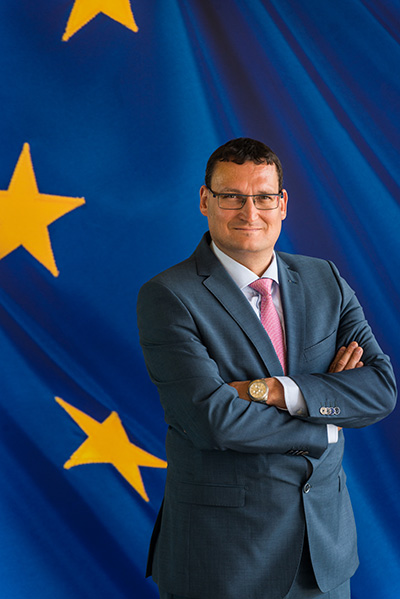
May 25th, 2022
Mr. Bart Biebuyck, Executive Director of the Clean Hydrogen Partnership (short CV here) introduces his views regarding the challenges and the scopes of the Clean Hydrogen Partnership, the successor of the FCH 2 JU, as well as his viewpoint on the role of Academia and specifically EASN as part of the newly created Stakeholders' group of the Clean Hydrogen Joint Undertaking.
Thank you for taking the time to talk to EASN today. Firstly, for readers who may not be familiar with Clean Hydrogen Partnership, can you tell us more about its mandate and objectives?
The Clean Hydrogen Partnership (or Joint Undertaking - JU) is a unique public private partnership supporting research and innovation (R&I) activities in hydrogen technologies in Europe.
We aim to strengthen and integrate EU scientific capacity, in order to accelerate the development and improvement of advanced clean hydrogen applications. The three members of the Joint Undertaking are the European Commission, fuel cell and hydrogen industries represented by Hydrogen Europe and the research community represented by Hydrogen Europe Research.
The Clean Hydrogen Partnership is the successor of the FCH 2 JU and was established in November 2021 with the adoption of the Council Regulation on establishing the Joint Undertakings under Horizon Europe. The EU supports the Clean Hydrogen Partnership with €1 billion euro for the period 2021-2027, complemented by at least an equivalent amount of private investment (from the private members of the partnership), raising the total budget to above €2 billion euro.
The European Commission announced recently in its communication "REPowerEU Plan" an additional investment of €200 million available for the Clean Hydrogen Partnership through the Horizon Europe Programme, as hydrogen is seen as key for accelerating the green energy transition and ensuring independence from on Russian fossil fuels .
The research and innovation activities of the Clean Hydrogen JU are guided to a large extent by the EU Hydrogen Strategy and the policy developments in this context, contributing to its implementation.
Our main focus is on renewable hydrogen production, as well as hydrogen transmission, distribution and storage, alongside selected fuel cell end-use technologies in transport, buildings and industry.
Why is the Clean Hydrogen JU supporting projects on the aviation sector?
With the European Green Deal the European Union has set the ambition to become the first climate-neutral continent by 2050, and has set clear political targets for aviation decarbonisation in both the Smart Sustainable Mobility Strategy (link) and in the Hydrogen Strategy (link). Hydrogen-powered aircrafts are a promising option in securing a climate-neutral Europe. Moreover, aeronautics is one of the EU's key high-tech sectors on the global market. With world leading aircraft companies and expertise in fuel cell technologies, Europe could play a vital role in driving the transformation of aviation to reduce emissions.
Are there any areas that you are focusing on in the research and innovation process?
One of the topics of the 2022 call for proposals is the development and optimisation of a dedicated Fuel Cells for Aviation: from dedicated stack (100s kW) up to full system (MWs).
In addition, we will provide funding for the development of specific cryogenic and lightweight storage system for aviation. The deadline of the call is on 31 May and we hope to receive some interesting proposals.
When could we then expect to see a hydrogen powered aircraft entry into service?
Hydrogen-powered aircraft is seen as a promising option to help Europe reach its Green Deal objective of climate neutrality by 2050. With the potential to join forces, if suitable structures and adequate funding are put in place, the Clean Aviation and Clean Hydrogen partnerships could play a key role in delivering hydrogen-powered aircraft demonstrators by 2030, for potential entry into service by 2035.
What are the technical challenges linked with the aeronautics sector?
The power of the fuel cell systems coming from the automotive industry is usually limited roughly to 100kW. Aviation needs are more in the range of 1 to 5MW depending on the size of the aircraft and/or the systems to supply with power. The stacks available today are not adapted to the aeronautic environment in which they will have to operate: low temperature, change of pressure, vibrations, etc. Costs, size and lifetime of the fuel cells must also be adapted to fit the aviation sector. Finally, safety issues shall be considered right from the start. The certifications rules should be created/adapted.
On the tanks for the storage of liquid hydrogen at cryogenic temperature, we have launched a topic under our call for proposals 2022, to study light-weight materials to reduce the tank weight and to ensure safe operation (sloshing, dynamic load, temperature and pressure effects) .
The European Aeronautics Science Network (EASN) is part of the recently created Stakeholders' group of the Clean Hydrogen Joint Undertaking. Could you tell me a little more about the objectives of this group?
The Stakeholders Group is an official advisory body, to be consulted on various horizontal issues or specific questions in areas relevant to the work of the Clean Hydrogen JU. The stakeholders group shall consist of representatives of sectors which generate, distribute, store, need or use clean hydrogen across the Union, including the representatives of other relevant European partnerships, as well as representatives of the European Hydrogen Valleys Interregional Partnership and of the scientific community. We are looking forward to collaborating with all our stakeholders during this exceptional and exciting time for hydrogen in Europe and across the world.